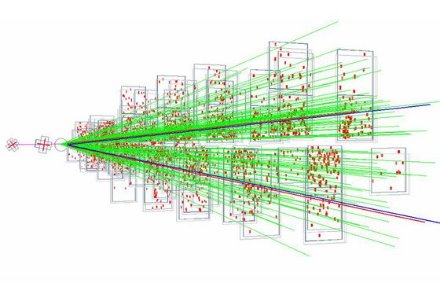Apr. 25, 2008 Research Highlight Physics / Astronomy
Particle accelerators go back to basics
Scientists obtain strong evidence that particle accelerators can split protons and neutrons into a quark–gluon plasma
 Figure 1: Typical event for indium–indium collisions seen in the Super Proton Synchrotron. Green lines are particle tracks and red lines are tracks identified as muons. © (2007) Hiroaki Ohnishi
Figure 1: Typical event for indium–indium collisions seen in the Super Proton Synchrotron. Green lines are particle tracks and red lines are tracks identified as muons. © (2007) Hiroaki Ohnishi
Common nuclear particles such as protons or neutrons—collectively known as hadrons—are made up from even tinier building blocks called quarks and gluons. Usually quarks and gluons are confined inside hadrons, but scientists believe that the hot dense fireball formed in high-energy nuclear collisions can break down the hadron structure. Now Hiroaki Ohnishi at RIKEN Nishina Center in Wako and his European co-workers may have recorded the first evidence of hadrons breaking down inside a particle accelerator to form a new state of matter called a quark–gluon plasma1.
“Quantum chromodynamics predicts that under extreme conditions such as high temperature and/or high density, quarks and gluons will no longer be confined in hadrons,” explains Ohnishi. “These conditions are expected just after the big bang or in the core of a neutron star.”
To recreate such conditions on Earth, the researchers collided heavy ions of indium inside the Super Proton Synchrotron at CERN in Switzerland. Such explosions give rise to pairs of elementary particles called muons, which can freely escape because they do not experience the strong nuclear force that holds quarks and gluons together. Therefore the momentum of the muons provides key information on the temperature and outward flow of the expanding fireball. Ohnishi and co-workers monitored 430,000 pairs of muons that were emitted during the collisions (Fig. 1).
As the fireball expands, the flow of muon pairs is expected to increase. However the latest experiment revealed an initial increase in muon flow, followed by a sudden decline. The researchers suggest that their result is the first direct evidence of a transition from hadron-based matter to a quark–gluon plasma.
At these extreme conditions, the wavefunction that predicts the possible positions of a quark becomes so wide that it overlaps with other particles. In other words, the quark does not belong to a single hadron, and the hadron no longer has any meaning. By understanding this quark-gluon plasma, scientists can begin to understand the mechanisms by which quarks stay confined within hadrons.
“The search for quark–gluon plasma and the investigation of matter at high temperatures are now very hot topics, and new results will soon come out from the CERN Large Hadron Collider [due to be completed this year],” says Ohnishi. “Those researches will be directed towards answering the question of what really happened just after the big bang.”
References
- 1. Arnaldi, R., Banicz, K., Castor, J., Chaurand, B., Cicalò, C., Colla, A., Cortese, P., Damjanovic, S., David, A. & de Falco., A. et al. Evidence for radial flow of thermal dileptons in high-energy nuclear collisions. Physical Review Letters 100, 022302 (2008). doi: 10.1103/PhysRevLett.100.022302
